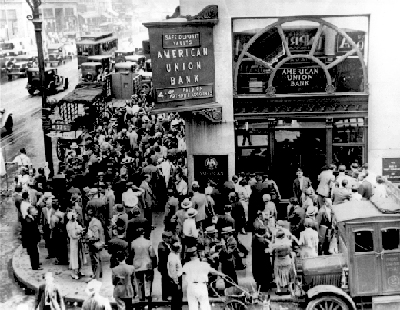
A bottomed-out stock market, business failures, bank failures, and bank runs like the one shown in the photo on the right, all deepened the economic crisis, and it quickly became a depression. A depression is when something hurts an economy (usually a national economy), creating high unemployment, low investment, and currency inflation. In 1929 the depression was caused by the Stock Market Crash of 1929 and the problems that came with it. But other factors can cause depressions. For instance, a war can cause a depression if a nation spends too much money fighting the war and fewer men are working because they are drafted to fight. A natural disaster can start a depression, too: After the terrible Indian Ocean tsunami of 2004, many nations struggled financially because their two main industries, fishing and tourism, were wiped out.
Throughout President Hoover’s term in office, the federal government struggled to stop the downturn and prevent an economic depression. But Hoover’s administration made some key missteps that made the depression worse. It passed the Smoot-Hawley Tariff in 1930, which restricted imports into the U.S. The goal was to boost American manufacturing by disallowing foreign-made goods, but angry trade partners around the world, whose economies were also in depression, refused to buy American goods in retaliation. This led to more U.S. businesses going bankrupt because no one would or could buy their products, and this created more unemployment. By January 1931, the new President’s Emergency Committee for Employment listed over four million Americans as unemployed.
The nation was now stuck in high unemployment, low economic activity, low stock market activity and value, and a banking crisis. It was the worst depression in U.S. history up to that point, and it quickly earned a new name: the Great Depression. The Great Depression spelled the end of President Hoover’s dreams of ending poverty forever.
How did the Smoot-Hawley Tariff make the Depression even worse?
| Your Responses | Sample Answers |
|---|---|
| The Smoot-Hawley Tariff restricted imports by the U.S., and that angered America’s trading partners, who refused to buy U.S. goods. U.S. manufacturing fell even more, and companies went bankrupt, which led to higher unemployment. |
